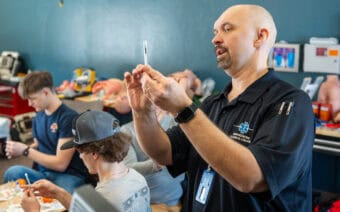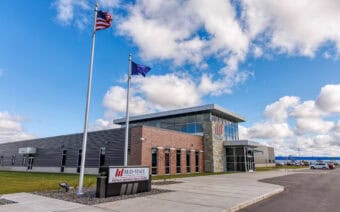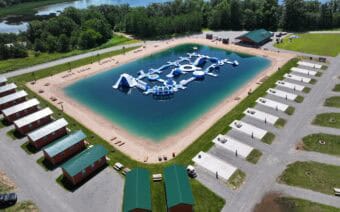
October 14, 2024
EAGLE RIVER – At its core, welding is the act of fusing together separate pieces.
Fittingly, at American Welding Institute’s Wisconsin campus, Kathy Huber – office administrator at the Advanced Welding Institute – said cohorts of students come to Eagle River as unfamiliar strangers and become unified like family.
It’s a phenomenon Huber said she’s witnessed twice a year during the five years she’s worked as the campus’ office director.
“We actually pull (students) from all over because we are ranked third in the nation for the top welding school,” she said. “We get kids from all over the country that come in here. Right now, we have one that’s on a Visa from Australia.”
Testing one’s ‘metal’
The Eagle River AWI’s campus, which opened in 2021, is the institute’s second location – an expansion from its original campus in South Burlington, Vermont.
Huber said the accredited program particularly appeals to recent high school graduates seeking intensive welding instruction, sans general education coursework.
“They’re very good with their hands – they’re creative,” she said of most AWI students. “They don’t like to sit in a classroom for long periods of time or write essays or have to do calculus.”
Huber said though many who enroll have historically not enjoyed formal education, “our graduation rate is about 98-99%.”
Some of the success can be attributed to Eagle River itself, she said, an area that allows the students – especially those hailing from bigger cities – to fully immerse themselves for the six-month semester amid limited distraction.
The amount of different American Welding Society certifications – demonstrating specific, valuable proficiencies – students can earn throughout the semester, Huber said, however, are unlimited.
“When they’re working on different types of metal and the different processes to weld on that metal, those are all different certifications,” she said. “We just had one student who graduated with 62 (certifications). As hard as they want to work, they can earn as many (certifications) that they can – but they also have to be able to pass the codes.”
AWI’s $25,000 tuition, Huber said, not only covers all of the structural and pipe welding coursework, necessary materials and books but also the additional certifications – she said would individually cost $350.
Huber said the private, for-profit institute works with students to fund tuition via financial aid, such as the Pell Grant and a variety of grant programs and scholarships.

Perhaps AWI’s most significant benefit, Huber said, is the level of guidance provided by the institute’s faculty.
“The instructors are amazing to work with – with that one-on-one touch, working with each of those students independently,” she said. “We really get to know each one individually.”
The Wisconsin campus staffs four full-time instructors and an assistant instructor, she said – providing maximal one-on-one education for an average of 50 students in fall and 25 in spring.
“When they’re doing the practice, the instructors will go into their booths with them,” she said. “(The instructors) will show them how – sometimes they will take (students’) hands and kind of show them the way they need to lay the bead. We cannot coach through any of the (certification) tests that they have to perform.”
In addition to AWI students undergoing the independent, pass-or-fail expectations of real-world welding projects, Huber said the challenging curriculum is also scheduled to prepare them for their eventual careers.
“It’s a tough program – it’s advanced,” she said. “We’re set up as kind of a work program – they’re welding 40 hours a week. They punch in and they punch out, every day.”
In light of AWI’s rigorous curriculum, Huber said previous experience is not required – nor is it necessarily preferred.
In fact, inexperienced students are “usually the best ones,” she said, as “they don’t have any bad habits from any prior teachers or family members.”
The hard work and career preparation, Huber said, pays off for the vast majority of AWI graduates, regardless of their backgrounds.
“Our employment rate is 99%,” she said. “These kids come from all over, and when they get out, they have great-paying jobs. A lot of them like to travel – there are traveling positions all over the U.S. – all over the world, actually. It’s a great opportunity for them.”
A bead on success
The original Vermont location of AWI was opened by Rick Irick in 2004.
Huber said after Irick – a welding specialist, retired from the U.S. Air Force – heeded suggestions from several companies to “open a good school somewhere, and teach kids how to actually weld.”
Huber said as the South Burlington campus earned a reputation for producing job-ready, versatile welders, Irick – “a huge Packers fan” – happened to visit Eagle River.
“He liked the area,” she said of Irick. “He liked the location and thought, ‘you know, this would be a good place to put another school.’ So he did a little bit of research, and he purchased the building and opened the school in 2012.”
Huber said AWI’s original Eagle River campus featured 20 welding booths.
When the program proved as successful as Irick had hoped, Huber said it moved to its current location at 555 Enterprise Way in 2020 and now features 56 welding booths.
She said the expanded capacity can facilitate not only the program’s full-time students but also accommodate training and American Welding Society-approved certification for professional welders.
Though the basic principles of welding persist, Huber said part of the appeal of the career is the array of possible projects – including skyscrapers, pipelines, bridges, coliseums and sculptures, as well as the industry’s endless updates in technology and methodology.
To accommodate for welding’s evolution, Huber said AWI continually curates its curriculum, while encouraging graduates to return and continue to learn.
“We do have a lifetime guarantee,” she said, “for any student that’s come here to come back and freshen up their skills in another process that they have not worked on in previous years.”
Welding, wilderness, wellbeing
With a population below 2,000, Huber said the Eagle River area itself may present only one or two students per year for AWI’s enrollment.
Though the six-month program’s tuition does not include housing, she said part of her duties entail ensuring students’ accommodations are secured.

Students are provided several short-term options, she said, with nearby access to the area’s natural beauty and related recreation.
“We get them all booked up and ask them where they want to live,” Huber said. “Some of the housing that we have through private owners are on lakes. Some kids will come in with a couple of buddies and they’ll rent one of those.”
Hiking, kayaking, boating, snowmobiling and year-round fishing are popular options for AWI students, she said, while others may simply enjoy the remoteness of the region.
“It’s the college experience, in a small hometown,” she said. “We have a lot to offer around here.”
In turn, Huber said, the influx of students has much to offer Eagle River.
As a fifth-generation resident, she said she’s heartened by AWI’s coordinated efforts to help with city events, food drives, fundraisers and the VFW.
“We are very strong with the community,” she said. “It’s just part of learning and experience and life in general that students need to understand the responsibility – as they’re going out into the public and being an adult – that they also start needing to help out their neighbors, their friends, the community or whoever needs help.”
Sparks fly
Among the strong bonds students form at AWI, Huber said the staff and faculty also enjoy the opportunity to meet and guide the next generation of welders.
“We get to know these students very well – their personalities, what they’re going to be good at and what jobs are out there that they would rock and roll at,” she said.
Each semester, she said, 10-15 companies visit AWI classrooms to put a real-life emphasis and value on the processes students are learning, while also connecting students to potential future employers.
To continue to provide the utmost education and experience, Huber said the Eagle River campus is breaking ground on a 5,000-square-foot expansion this month.
As another cohort settles into its semester, Huber said she finds it rewarding to see so many young people pursuing what she considers a great career.
“We see what they’ve learned and who they go to work for and what they have created – where they have gone in their life,” she said of AWI students. “There’s so much welding that’s out there. Every day it’s a new learning experience.”
Visi awi.edu/wisconsin-campus for more information.
 Green Bay Packers, NFL officially set dates for draft
Green Bay Packers, NFL officially set dates for draft ‘An experience worth remembering, memories worth believing in’
‘An experience worth remembering, memories worth believing in’








